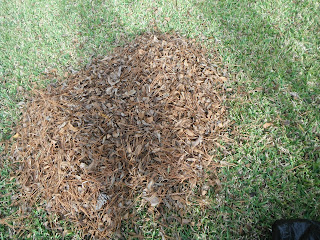 Every year a ritual takes place across the country and the world. This annual chore takes place usually in the fall or winter months and is either loved or hated depending on how much you did it as a child. I am of course talking about the wonderful, joyous chore of raking your lawn. This job is treated by many as a burdensome waste of time with you endlessly raking, bagging and disposing of your leaf litter at the local dump or burn pile. For others it is a great opportunity for to add to the community compost pile in which all this leaf litter can be disposed of naturally and makes a perfectly useful substance.
Every year a ritual takes place across the country and the world. This annual chore takes place usually in the fall or winter months and is either loved or hated depending on how much you did it as a child. I am of course talking about the wonderful, joyous chore of raking your lawn. This job is treated by many as a burdensome waste of time with you endlessly raking, bagging and disposing of your leaf litter at the local dump or burn pile. For others it is a great opportunity for to add to the community compost pile in which all this leaf litter can be disposed of naturally and makes a perfectly useful substance. If your are lucky enough to live in one of those communities you should take advantage of this service and add to the community compost. If you live in a community that doesn't have one of these services and you want to create compost you are left to your own means to make it. I was personally confronted with this very problem in my current location. I had a yard full of leaf litter, a desire for some compost and no community pile to add it too.
I did some research and found out that a easy way to make a free/cheap compost bin is to use old shipping pallets. This was a perfect solution to my problem since I am tight on money the idea of using shipping pallets appealed to me. These pallets are fairly easy to find too if you are looking in the right locations.
Some good places to look include.
- Hardware Stores
- Lumber Yards
- Big Box Stores
- Large Grocery Stores
- Distribution Centers
- Manufacturing Plants
- Etc.
I built my compost bin using six pallets that I got from a local lumbar yard/hardware store. I laid the pallets our in a rectangular shape with the bin being two pallets long and one pallet wide. I fastened them together using 2 1/2 in screws spaced as evenly along 2x4 supports as I could. With the first five in place I then took the sixth pallet and a pair of heavy duty door/barn hinges and attached it to the other five pallets. With the door in place and secured by a old bungee cord the bin was ready to fill. By the time I was done picking up the yard I was able to get around 75% of my yards leaf litter into the bin.
 The only money I spent on it was the gas in the car to pick up the pallets and little bit on screws to assemble it. In return I will get nutrient rich compost at a fraction of the cost of commercially bought compost and you can control what was put in the bin.
The only money I spent on it was the gas in the car to pick up the pallets and little bit on screws to assemble it. In return I will get nutrient rich compost at a fraction of the cost of commercially bought compost and you can control what was put in the bin. In order to help the bin along a balance between wet and dry and the proper amount of nitrogen vs carbon must be maintained in order to decompose at the optimum rates. Nitrogen is found in green organic matters such as lawn trimmings, salad ends, fresh leaves and many kitchen vegetable wastes. Carbon is found in the brown organic matter like dry leaves, twigs, dry grass, and straw. I have found the quickest way to determine something is off is smell. Compost that is off will have a rotten smell which some people say smell like eggs gone bad. Compost that is going good will simply smell like good soil and be moist but not sopping wet. Semi frequent turning of the compost using a pitchfork will speed up the process and will help aerate the compost if it it to wet.
After the leaf litter and added vegetable scraps has been composted I will use it in my gardens and spread out on my lawn as fertilizer.
Until next time time my fellow environmentalists
Josh

No comments:
Post a Comment